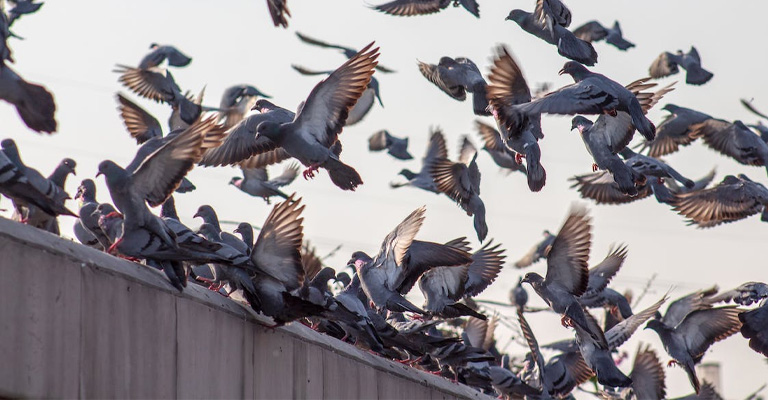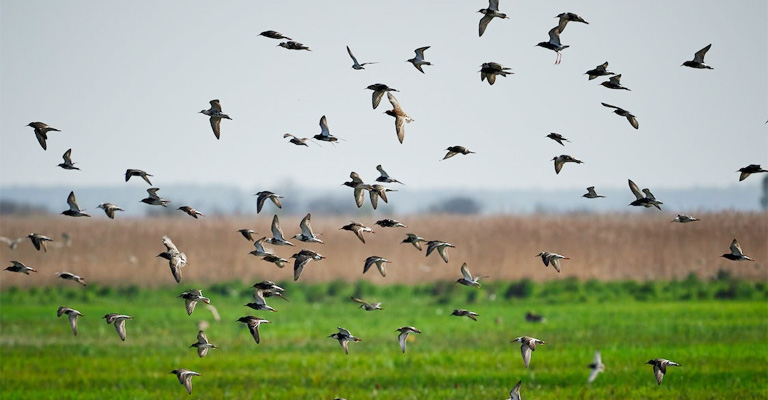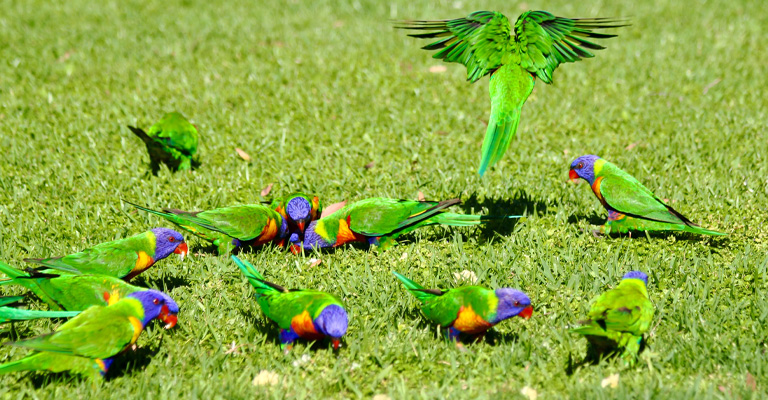The enchanting sight of an abundant array of birds gracing your yard with their presence often sparks curiosity about the reasons behind this avian phenomenon.
As you enter your outdoor haven, the fluttering wings, cheerful melodies, and diverse plumage offer a captivating tableau of nature’s marvels.
Understanding the motivations that draw these feathered visitors can unveil the intricate tapestry of interactions between your environment and the avian world.
The question, “Why are there so many birds in my yard?” unravels a narrative of ecological dynamics, seasonal rhythms, and the harmonious coexistence of nature’s inhabitants.

Why Are There So Many Birds In My Yard? [9 Reason]
Here are many possible reasons why you have so many birds in your yard. Here are nine of them, along with a brief description of each:
Food Availability
Your yard might provide a rich and diverse source of food for birds. Whether it’s flowering plants, fruit-bearing trees, or insects attracted to your garden, birds are drawn to places where they can easily find nourishment.
Habitat Diversity
A yard with a variety of plants, trees, and shrubs creates a more inviting environment for birds.
Different species of birds have varied habitat preferences, and a diverse landscape can accommodate their various needs for nesting, perching, and foraging.
Water Source
If your yard includes a bird bath, pond, or any other water feature, it could be a crucial attraction for birds, especially during hot or dry periods.
Birds require water not just for drinking but also for bathing and preening their feathers.
Shelter and Nesting Opportunities
Trees, shrubs, and even dense vegetation can provide birds with safe shelter from predators and harsh weather conditions.
Moreover, they might find suitable nesting sites within the foliage, encouraging them to stay in your yard.
Migration Rest Stop
Depending on the location of your yard, it could be situated along a migratory route for certain bird species.
Birds might use your yard as a rest stop to refuel and rest during their long journeys.
Urbanization Effects
Many bird species have adapted to urban environments, finding suitable food and nesting opportunities within cities and suburban areas.
If your yard is in or near an urban setting, it could be attracting these adaptable species.
Feeder and Food Stations
If you have bird feeders and provide a steady supply of birdseed, suet, or other bird-friendly foods, your yard becomes an enticing feeding station, drawing various bird species seeking an easy meal.
Natural Insect Control
Birds are natural pest controllers, as they feed on insects and larvae that could harm your plants.
If your yard has a healthy insect population, birds might be drawn to it as a valuable food source.
Minimized Predation Risk
A well-maintained yard with limited exposure to predators like outdoor cats might be perceived as a safer haven for birds. Less threat from predators can encourage birds to frequent your yard more often.
The multitude of birds in your yard can be attributed to a combination of factors such as the availability of food, diverse habitats, water sources, shelter, and nesting opportunities.
Additionally, your yard’s location, the presence of bird feeders, and even its role in supporting migratory birds can contribute to the vibrant avian activity you’re experiencing.
How Do I Know If A Bird Is Migrating Or Roosting?

There are some clues that can help you determine if a bird is migrating or roosting. Here are some tips for identifying them:
Time Of The Day
Migrating birds usually fly at night or early morning when the air is more relaxed and calmer. They may also avoid flying during bad weather, such as storms or strong winds.
Roosting birds, on the other hand, may gather in the evening or during the day, depending on their species and habits. They may also roost in different places depending on the season and the weather.
The Direction Of Flight
Migrating birds usually fly in a consistent direction, following a general route that may vary slightly depending on the wind and the landscape.
They may also fly in a V-shaped formation or a line to save energy and communicate with each other.
Roosting birds may fly in different directions, depending on where they are going to roost. They may also fly in smaller groups or individually.
Behavior And Vocalization
Migrating birds may be silent or make soft calls to keep in touch with their flock mates.
They may also fly at high altitudes to avoid predators and obstacles. Roosting birds may be noisy or quiet, depending on their species and mood. They may also fly at lower altitudes to find suitable roosting sites.
Some roosting birds may perform spectacular displays before settling down, such as starlings forming murmurations.
Type Of Bird
Some birds are more likely to migrate than others, depending on their habitat, diet, and adaptation. For example, birds that live in cold regions or feed on insects may migrate to warmer areas or where food is more abundant.
Birds that live in temperate regions or feed on seeds may stay year-round or make short-distance movements.
Some examples of migratory birds are geese, swallows, and hummingbirds. Some examples of non-migratory or partially migratory birds are crows, sparrows, and pigeons.
How Can I Attract More Birds To My Yard?

There are many ways to make your yard more appealing to birds, but the main factors are food, water, shelter, and nesting sites.
Here are some tips based on the web search results I found:
Food
Birds need a reliable and varied food source to survive and thrive. You can offer them different types of seeds, suet, nuts, fruit, nectar, and kitchen scraps in different types of feeders.
For example, black oil sunflower seeds are popular with many songbirds, while nyjer seeds attract finches and nuthatches. Suet cakes provide fat and energy for woodpeckers and chickadees, while fruit and nectar attract orioles and hummingbirds.
You can also plant native flowers, shrubs, and trees that produce seeds, berries, or nectar for birds to feed on naturally.
Water
Birds need water for drinking and bathing, especially in hot or dry seasons. You can provide them with a birdbath or a shallow dish of water that is clean and fresh.
To make your water source more attractive, you can add a dripper, mister, or bubbler to create motion and sound.
You can also place your water source near some plants or rocks that provide cover and perching spots for birds.
Shelter
Birds need shelter from predators, weather, and competitors. You can create shelter for birds by planting dense bushes, evergreens, or vines that offer hiding places and protection.
You can also provide artificial shelters, such as birdhouses, roosting boxes, or brush piles that offer insulation and security. You can also avoid using pesticides or chemicals that may harm birds or their prey.
Nesting Sites
Birds need nesting sites to raise their young and ensure the survival of their species.
You can provide nesting sites for birds by leaving some natural materials such as twigs, grasses, feathers, or moss in your yard for them to use. You can also offer nest boxes or platforms that are suitable for different species of birds.
You can also avoid disturbing or removing nests that you find in your yard.
By following these tips, you can attract more birds to your yard and enjoy their beauty and songs.
FAQ
Birds are attracted to your yard due to the abundant food sources, diverse habitats, and water availability. Your garden might offer ideal conditions for nesting and shelter, making it a haven for various species seeking a safe and nourishing environment.
Yes, bird feeders are a significant draw. Providing a consistent supply of birdseed, suet, or other foods creates an enticing feeding station. This can lead to increased bird activity as different species flock to your yard for easy access to sustenance.
Absolutely. During migration seasons, your yard might be situated along a bird’s migratory route. It could also provide a crucial resting stop for tired travelers, leading to a higher concentration of birds in search of rest and nourishment.
A diverse landscape with trees, shrubs, and flowering plants offers birds varied habitats for nesting, perching, and foraging. This diversity attracts a range of species seeking specific conditions, contributing to the richness of bird life in your yard.
Water sources like bird baths, ponds, or fountains are essential. Birds require water not just for drinking but also for bathing and preening. The availability of clean water can significantly increase bird activity, as it fulfills both their hydration and grooming needs.
Conclusion
In unraveling the mysteries behind the multitude of birds gracing your yard, you delve into the depths of nature’s intricate ballet. The bustling activity of these winged visitors is a testament to the captivating allure your yard presents – a haven of sustenance, shelter, and safety.
As you continue to observe these aerial dancers, you’re not only nurturing the well-being of your immediate ecosystem but also gaining a glimpse into the broader symphony of life that encompasses us.
The influx of birds in your yard embodies the magic of nature’s interconnectedness, and each fluttering visitor becomes a testament to the beauty of sharing a space with the wild.